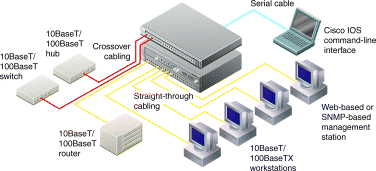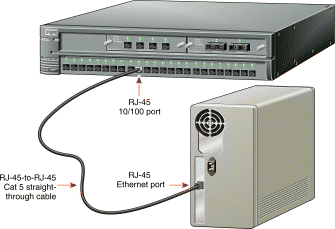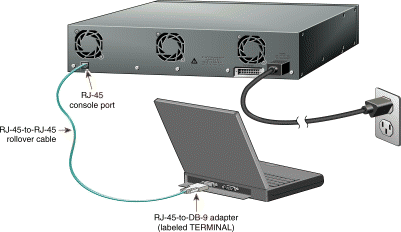|
|


| Take Out What You Need |
Catalyst 2900 series XL Ethernet switch | |
|
|
Catalyst 2900 Series XL Installation Guide and Release Notes for Catalyst 2900 Series XL and Catalyst 3500 Series XL Cisco IOS Release 12.0(5)XP | |
|
|
RJ-45-to-RJ-45 rollover console cable | |
|
|
AC power cable | |
|
|
RJ-45-to-DB-9 serial connector | |
|
|
RJ-45-to-DB-9 terminal connector | |
|
|
Rack-mount kit | |
|
|
Rubber feet | |
| Cable the Switch |

1. Connect a Category 5 straight-through cable (not supplied) to a 10/100 port on the front panel of the switch.
2. Connect the other end of the cable to the RJ-45 port of the PC, workstation, server, or router.
1. Connect a Category 5 crossover cable (not supplied) to a 10/100 port on the front panel of the switch.
2. Connect the other end of the cable to an RJ-45 port of the target switch or hub.

1. Connect one end of the supplied AC power cable to the rear panel of the switch.
2. Connect the other end of the power cable to a grounded AC outlet.
1. Connect the supplied flat, blue, rollover cable to the CONSOLE port on the switch rear panel.
2. Connect the other end of the cable to a terminal or PC with terminal-emulation software. Use one of the supplied adapters if you need to.
The terminal or emulation software must match the settings on the console port. Check your terminal or emulation software to be sure it matches the settings listed below, and reconfigure it if it does not.
9600 baud
No parity
8 data bits
1 stop bit
| Assign IP Information to the Switch |
The first time that you access the switch, it runs a setup program that prompts you for IP and other configuration information. This information is needed so that the switch can communicate with local routers and the Internet. It is also required if you plan to use Cisco Visual Switch Manager (CVSM) to configure and manage the switch.
Before you start the switch, get the following information from your system administrator:
Use this procedure to assign IP information to the switch:
1. Enter Y at the first prompt:
Continue with configuration dialog? [yes/no]: y
2. Enter the switch IP address, and press Return:
Enter IP address:
3. Enter the subnet mask, and press Return:
Enter IP netmask:
4. Enter Y at the next prompt to specify a default gateway (router):
Would you like to enter a default gateway address? [yes]: y
5. Enter the IP address of the default gateway, and press Return.
IP address of the default gateway:
6. Enter a host name for the switch, and press Return.
Enter a host name:
7. Enter a secret password, and press Return.
Enter enable secret:
The initial configuration displays:
The following configuration command script was created:
interface VLAN1
ip address 172.20.153.36 255.255.255.0
ip default-gateway 172.20.153.01
enable secret 5 $1$M3pS$cXtAlkyR3/6Cn8/
snmp community private rw
snmp community public ro
cluster enable cls_name
end
Use this configuration? [yes/no]:
8. Verify that the addresses are correct.
9. Enter Y, and press Return.
If the addresses are not correct, enter N, press Return, and begin again at Step 1.
After you complete the setup program, the switch can run the created default configuration. If you want to change this configuration or want to perform other management tasks, use one of these tools:
To use the CLI, enter commands at the switch> prompt. Refer to the Cisco IOS Desktop Switching Software Configuration Guide or the Cisco IOS Desktop Switching Command Reference (online only) for configuration information.
To use CVSM, go to Section 4, "Access the Switch from Your Browser."
| Access the Switch from Your Browser |
After you assign an IP address to the switch, you can access the switch from your browser and use CVSM to view or change configuration settings. If this is a command switch (Enterprise Edition only), you can use Cluster Management software to configure other switches. To use web-based tools, follow the procedure to set the appropriate browser options.
CVSM supports the following platforms and network browsers:
| Operating System | Minimum Operating System Requirements | Netscape Communicator | Microsoft Internet Explorer |
|---|---|---|---|
Windows 95 | Service Pack 1 | 4.5, 4.51, or 4.61 | 4.01a or 5.0 |
Windows 98 | Second Edition | 4.5, 4.51, or 4.61 | 4.01a or 5.0 |
Windows NT | Service Pack 3 | 4.5, 4.51, or 4.61 | 4.01a or 5.0 |
Solaris 2.5.1 | SUN-recommended patch cluster for the OS and Motif library patch 103461-24 | 4.5, 4.51,or 4.61
| Not supported |
Netscape Communicator version 4.6 is NOT Supported.
1. From the menu bar, select Edit>Preferences.
2. In the Preferences window, click Advanced.
3. Select the Enable Java, Enable JavaScript, and Enable Style Sheets check boxes.
4. From the Advanced drop-down list, select Cache.
5. Select Every time.
6. Click OK.
1. From the menu bar, select View>Internet Options.
2. In the Internet Options window, click Advanced.
3. Scroll through the list of options to Java VM, select the Java JIT compiler enabled and Java logging enabled check boxes, and click Apply.
4. Click General. In the Temporary Internet Files section, click Settings. The Settings window opens.
5. Select Every visit to the page, and click OK.
6. In the Internet Options window, click Security.
7. In the Zone drop-down list, select Trusted Sites Zone, and click Custom.
8. Click Settings.
9. In the Java>Java permissions section, select Custom. Click the Java Custom Setting, which appears at the bottom of the window.
10. In the Trusted Sites Zone window, click Edit Permissions.
11. If the buttons under Run Unsigned Content are not available, select either Medium or Low security in the Reset Java Permissions list box. Click Reset.
12. Under Run Unsigned Content, select Enable, and click OK.
13. In the Security Settings window, click OK.
14. In the Internet Options window, click Security. Verify that the Zone drop-down list is set to Trusted Sites Zone.
15. In the Trusted Sites Zone section, click Add Sites.
16. In the Trusted Sites Zone window, deselect the Require server verification check box.
17. In the Add this Web site to the Zone field, enter the IP address of the switch.
18. Click Add, and then click OK.
19. In the Internet Options window, click Apply, and then click OK.
Once the browser is configured, display the CVSM as follows:
1. Enter the IP address of the switch in the Location field (the Address field if you are using Internet Explorer).

2. Press Return. The universal access page for your switch displays.

3. Click Visual Switch Manager to display the CVSM home page.
See the Catalyst 2900 Series XL Installation Guide for detailed instructions on installing the Cisco 2900 series XL switch. See the Cisco IOS Desktop Switching Software Configuration Guide for detailed instructions on using CVSM, the Cisco IOS CLI, and Cluster Management software to configure and manage switches. See Release Notes for the Catalyst 2900 Series XL and Catalyst 3500 Series XL Cisco IOS Release 12.0(5)XP for recent information about the Catalyst 2900 series XL switch.
![]()
![]()
![]()
![]()
![]()
![]()
![]()
![]()
Posted: Thu Apr 13 17:53:58 PDT 2000
Copyright 1989 - 2000©Cisco Systems Inc.